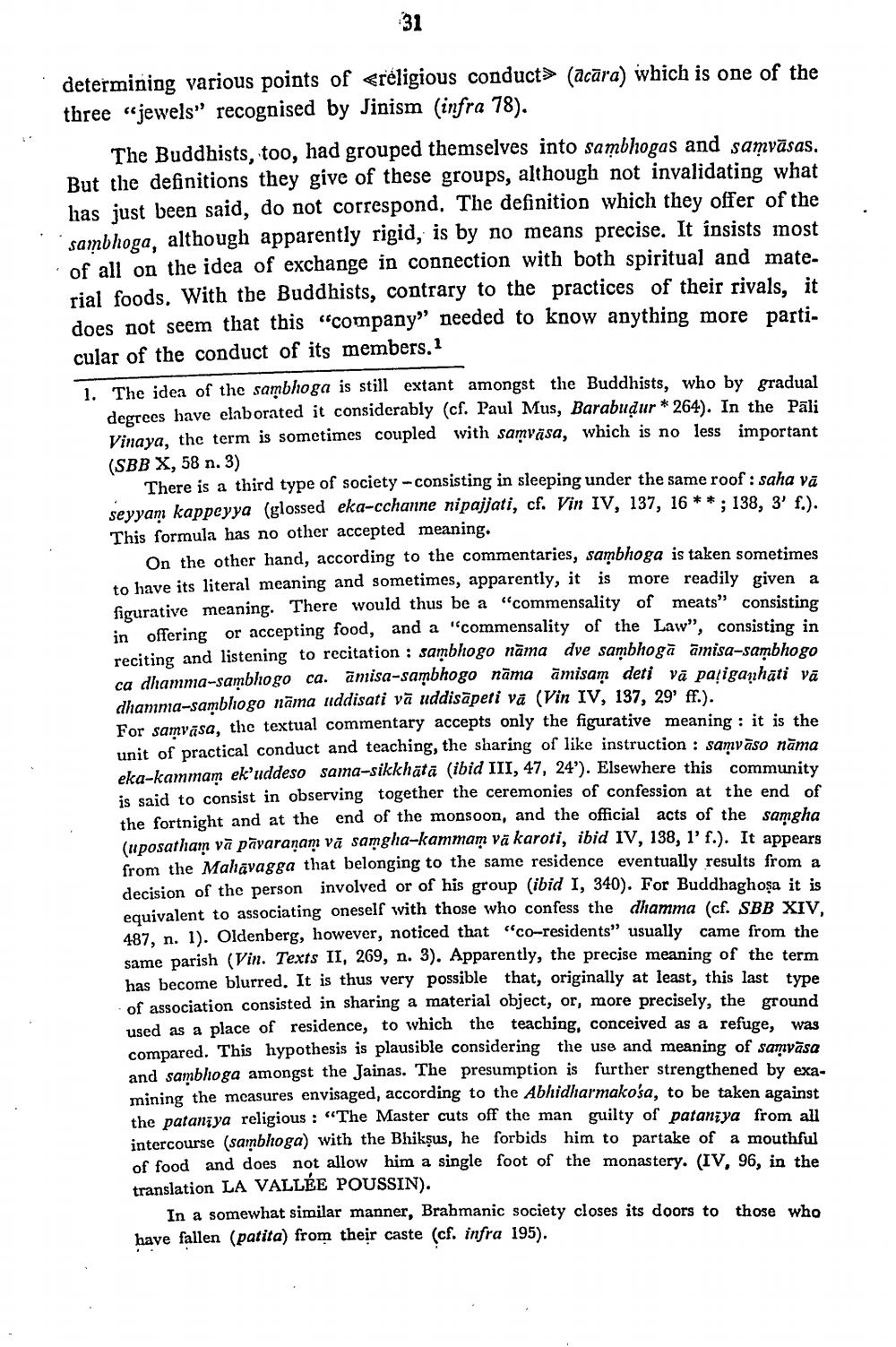________________
determining various points of créligious conduct> (acāra) which is one of the three jewels" recognised by Jinism (infra 78).
The Buddhists, too, had grouped themselves into sambhogas and samväsas. But the definitions they give of these groups, although not invalidating what has just been said, do not correspond. The definition which they offer of the sambhoga, although apparently rigid, is by no means precise. It insists most of all on the idea of exchange in connection with both spiritual and material foods. With the Buddhists, contrary to the practices of their rivals, it does not seem that this company” needed to know anything more particular of the conduct of its members. 1
1. The idea of the sambhoga is still extant amongst the Buddhists, who by gradual
degrees have elaborated it considerably (cf. Paul Mus, Barabudur * 264). In the Pāli Vinaya, the term is sometimes coupled with samväsa, which is no less important (SBB X, 58 n. 3)
There is a third type of society - consisting in sleeping under the same roof: saha vā seyyam kappeyya (glossed eka-cchanne ni pajjati, cf. Vin IV, 137, 16 **: 138, 3' f.). This formula has no other accepted meaning.
On the other hand, according to the commentaries, sambhoga is taken sometimes to have its literal meaning and sometimes, apparently, it is more readily given a figurative meaning. There would thus be a "commensality of meats" consisting in offering or accepting food, and a "commensality of the Law", consisting in reciting and listening to recitation : sambhogo nāma dve sambhogā āmisa-sambhogo ca dhamma-sambhogo ca. amisa-sambhogo nāma amisam deti vā paliganhati ya dhamma-sambhogo nāma addisati vā uddisāpeti vā (Vin IV, 137, 29' ff.). For samvasa, the textual commentary accepts only the figurative meaning: it is the unit of practical conduct and teaching, the sharing of like instruction : samvāso nama eka-kammam ek'uddeso sama-sikkhātā (ibid III, 47, 24'). Elsewhere this community is said to consist in observing together the ceremonies of confession at the end of the fortnight and at the end of the monsoon, and the official acts of the samgha (uposatham vā pāyaranam vă samgha-kammam va karoti, ibid IV, 138, 1' f.). It appears from the Mahavagga that belonging to the same residence eventually results from a decision of the person involved or of his group (ibid I, 340). For Buddhaghosa it is equivalent to associating oneself with those who confess the dhamma (cf. SBB XIV. 487. n. 1). Oldenberg, however, noticed that "co-residents" usually came from the same parish (Vin. Texts II, 269, n. 3). Apparently, the precise meaning of the term has become blurred. It is thus very possible that, originally at least, this last type of association consisted in sharing a material object, or, more precisely, the ground used as a place of residence, to which the teaching, conceived as a refuge, was compared. This hypothesis is plausible considering the use and meaning of samvāsa and sambhoga amongst the Jainas. The presumption is further strengthened by examining the measures envisaged, according to the Abhidharmakosa, to be taken against the pataniya religious : "The Master cuts off the man guilty of pataniya from all intercourse (sambhoga) with the Bhiksus, he forbids him to partake of a mouthful of food and does not allow him a single foot of the monastery. (IV, 96, in the translation LA VALLÉE POUSSIN).
In a somewhat similar manner, Brahmanic society closes its doors to those who have fallen (patita) from their caste (cf. infra 195).




